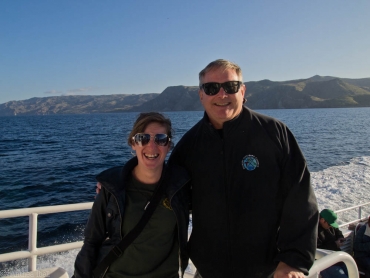Catalina Hyperbaric Chamber is run through the University of Southern California. Karl Huggins, a long time supporter of the scholarship, is the Director of the Chamber and invited me to learn more about his work. I arrived in Avalon, one of two towns on the island, after a long day travelling. The beautiful ‘casino’ building sits on a small peninsular that overlooks the dive park, a protected area used often for training. The California coast is renowned for its beautiful kelp forests which are home to an array of temperate fishes. From Avalon we drove North West along the island to the USC Wrigley Marine Science Center.
The chamber has been on the island since the 60’s when it was donated to the university. The chamber offers emergency treatment for diving accidents. Working closely with the Los Angeles County Baywatch Lifeguards and US Coast Guard patients are able to gain the most appropriate care in a short amount of time
The chamber itself has two locks and has space to treat numerous patients at the same time. A volunteer crew allows the chamber to be staffed 24hours a day, every day of the year. Through the Chamber and The Wrigley Marine Science Center, training is provided in Emergency Response Diver, Advanced Decompression Physiology and Hyperbaric Chamber Operations.
During my visit I was able to assist in running a dive by opening and closing valves to increase the pressure, vent air and decrease pressure. It was an exciting process and not as stressful as I imagine it would have been had there actually been anyone in the chamber! I also had the opportunity to go for a dry dive in the chamber. This is something I have always been interested in doing, but have not been willing to get a diving injury just to try it!
So we started up the chamber, I took off my shoes and anything that could spark and stepped inside the room. Max Brummett, a volunteer, and I were taken to 130 feet. The increase in pressure brings with it an increase in temperature, rising to 40°C on the decent. We carried out a few tasks to demonstrate the pressure increase. With a regular Intravenous drip the increased pressure would stop the liquid from dripping through to the patient’s tube so specialised bags are used. We set it up and as the pressure increased we were able to add air so that the fluid would continue to flow. We also used a suction tube which functions due to the outside pressure being lower. These are both important features of the chamber to provide patients appropriate care while being treated for their symptoms. One of the fascinating things about being in the chamber at 130 feet was the change in our voices – the thick air means that our voices sounded as though we were breathing helium.
On the ascent the chamber cools with the decrease in pressure; getting down to 1°C! So we layered up and completed our safety stops at 30ft, 20ft and 10ft. From 10 ft we were on 100% Oxygen from regulators.
[vimeo 35634004 550 309]
The Los Angeles County Baywatch Lifeguards were kind enough to take me out on patrol. Two lifeguards patrol the Western end of the island and another team based out of Avalon patrol the East end of the island. The two men act as the firemen, lifeguards and paramedics and their range is a large area covering 40 square miles of land and the surrounding waters.
Catalina was bought by the Wrigley family in 1919 that went on to invest in preserving the island. Much of the land remains undeveloped and is managed by the Conservancy. Conservancy staff monitor endemic species; both fauna and flora and maintain roads and signs. There is also a program in place to attempt to introduce nursery raised endemic seedlings to the island in an attempt to minimize the spread of introduced plants.
Karl also organised a visit to the Aquarium of the Pacific, in Long Beach, California. Paul Dimeo, the Diving Safety Officer was generous enough to let me dive in the exhibits. First was a dive in the Tropical exhibit. During the dive was a feeding and I was in charge of getting food into the ray’s mouths which is easier said than done. We then went for a tour around the tank, visiting each of the windows. The second dive was in the Blue Cove exhibit which is a local Californian ecosystem. With kelp reaching to the surface, massive Giant Bass with eyes the size of baseballs, moray eels, leopard sharks and cool water.
The Marine Mammal Care Center in Fort MacArthur, LA treats and monitors stranded mammals, namely Pinipeds. I visited the centre to learn more about their work. They treat around 550 animals a year, with the busiest time being during pupping season from February to September. There are 7 rehabilitation centres along the coast of California and the San Pedro center only covers 60miles of beach but is one of the busiest due to the development and large population in the Los Angeles County. They treat a variety of pinnipeds including Elephant Seals, Harbour Seals and Californian Sea Lions, commonly with bacterial infections and malnutrition.
I had a great start to my time in California. Karl was incredibly generous and welcoming. He gave me interesting tours, taught me a lot and was great company. Thanks to Max Brummett and Baywatch for making my time on Catalina even more exciting! Thanks to Paul Dimeo and the staff at the Aquarium of the Pacific for all their support. And a big thank you to Jeff Bozanic and his family for all of their hospitality!






















